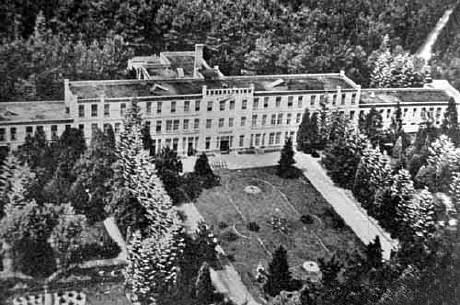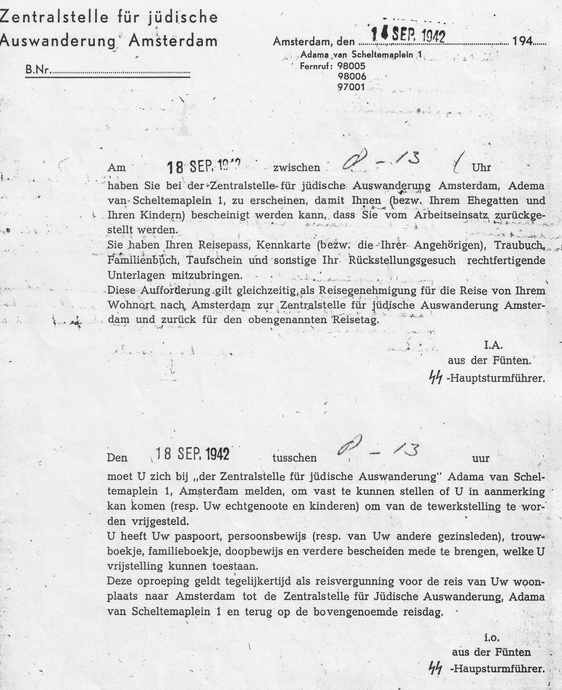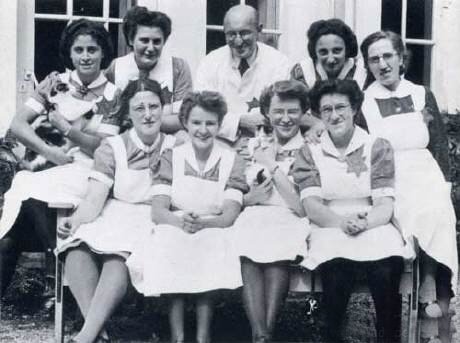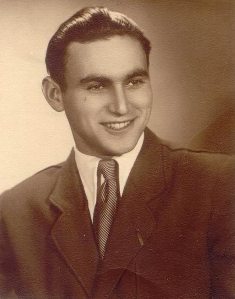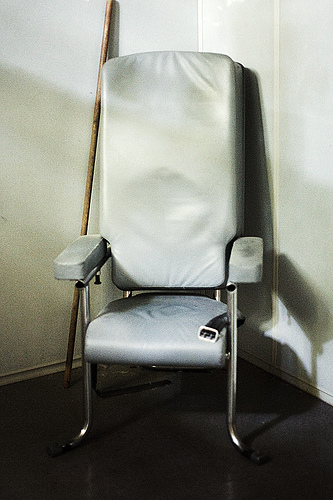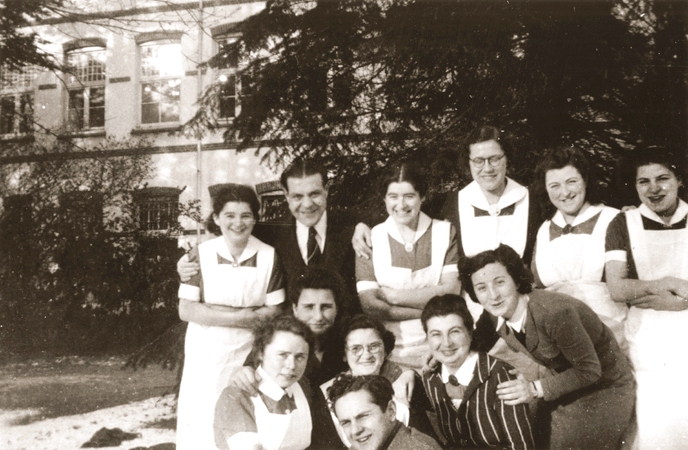Holocaust Education & Archive Research Team |
|
Occupation German Occupation of Europe Timeline
-
[The Occupied Nations]
Poland Austria Belgium Bulgaria Denmark France Germany Greece Hungary Italy Luxembourg The Netherlands Norway Romania Slovakia Soviet Union Sudetenland | |||
Apeldoornse Bos Deportation of Psychiatric Patients to Auschwitz- Birkenau
The Apeldoornse Bos was a Jewish psychiatric institution, amid the forests near Apeldoorn, Jews were treated for psychiatric disorders using modern methods from 1909 onwards.
The Apeldoornse Bos expanded rapidly and by 1938 the institution had 900 patients, including seventy-four mentally retarded and wayward children at the Paedagogium Achisomog.
The evacuation from the Jewish mental hospital in Apeldoorn, in Holland on the 21 January 1943 remains one of the most horrible chapters in the dark history of the holocaust.
Dr Jacob Presser recounts the terrible scenes:
They were escorted into the lorries with pushes and blows, men, women and children, most of them inadequately clad for the cold winter night. As one eyewitness later recalled;
“I saw them place a row of patients, many of them older women on mattresses at the bottom of one lorry, and then load another load of human bodies on top of them. So crammed were these lorries that the Germans had a hard job to put up the tailboards.”
From the very start, the patients were thrown together indiscriminately, children with dangerous lunatics, imbeciles with those who were not fit to be moved. The lorries sped to the station, the station-master at Apeldoorn who stood by the train throughout, provided more eyewitness particulars. At first everything went smoothly.
The earliest arrivals, mainly young men, went quietly into the freight wagons at the front of the train, forty in each, when the station-master opened the ventilators, the Germans immediately closed them again.
At first, men and women were put into separate freight cars, but later they were all mixed together. As the night wore on, the more seriously ill were brought into the station. Some wore straight-jackets and they entered the wagons and then lent helplessly against the wall of the wagons.
The report mentions the harrowing case of a young girl in a straight-jacket:
“I remember the case of a girl of twenty to twenty-five, whose arms were pinioned in this way, but who otherwise was stark naked. When I remarked on this to the guards, they told me this patient had refused to put on clothes, so what could they do but take her along as she was.
Blinded by the light that was flashed in her face, the girl ran, fell on her face and could not, of course, use her arms to break the fall. She crashed down with a thud, but luckily escaped without serious injury. In no time she was up again and unconcernedly entered the wagon.”
In general, the station master stated, “the loading was done without great violence. The ghastly thing was that when the wagons had to be closed, the patients refused to take their fingers away. They simply would not listen to us and in the end the Germans lost patience. The result was a brutal and inhuman spectacle.”
Early the next morning Hauptsturmfuhrer Ferdinand Aus der Funten who directed Eichmann’s branch office in Amsterdam, responsible for the deportations of Jews from Holland, called for volunteers among the nurses to accompany the train.
Some twenty came forward, Aus der Funten selected another thirty, the “volunteers” travelled in a separate wagon, at the back of the train. All of the nurses were offered the choice of returning home immediately after the journey, or working in a really modern mental home.
The transport reached the Auschwitz-Birkenau on the 24 January 1943, with 921 Jewish patients, including children and medical personnel. After a selection 16 men and 36 women were admitted into the camp, the remaining 869 people are murdered in the gas chambers.
Rudolf Vrba, a prisoner, who later escaped from Birkenau, recalled this particular transport:
“In some of the trucks nearly half the occupants were dead or dying, more than I have ever seen. Many obviously had been dead for several days, for the bodies were decomposing and the stench of disintegrating flesh gushed from the open doors.
This, however, was no novelty to me. What appalled me was the state of the living. Some were drooling, imbecile, live people with dead minds. Some were raving, tearing at their neighbours, even at their own flesh.
Some were naked, though the cold was petrifying; and above everything, above the moans of the dying or the despairing, the cries of pain, of fear, the sound of wild, frightening, lunatic laughter rose and fell.
Yet amidst all this bedlam, there was one spark of splendid, unselfish sanity. Moving among the insane were nurses, young girls, their uniforms torn and grimy, but their faces calm and their hands never idle. Their medicine bags were still over their shoulders and they had to fight to keep their feet, but all the time they were working, soothing, bandaging, giving an injection here, an aspirin there.
Not one showed the slightest trace of panic.” “Get them out!” roared the SS-men, “Get them out, you bastards.”
A naked girl about twenty with red hair and a superb figure suddenly leaped from a wagon and lay squirming, laughing at my feet. A nurse flung me a heavy Dutch blanket and I tried to put it round her, but she would not get up. With another prisoner, a Slovak called Fogel, I managed to roll her into the blanket.
“Get them to the lorries!” roared the SS. “Straight to the lorries! Get on with it for Christ’s sake!”
Somehow Fogel and I broke into a lumbering run, for this beautiful girl was heavy. The motion pleased her and she began clapping her hands like a child. An SS club slashed across my shoulders and the blanket slipped from my numbed fingers.
“Get on you swine! Drag her.”
I joined Fogel at the other end of the blanket and we dragged her, bumping her over the frozen earth for five hundred yards. Somehow she clung to the blanket, not laughing now, but crying, as the hard ground thumped her naked flesh through the thick wool.
“Pitch her in! Get her on the lorries!”
The SS men were frantic for here was something they could not understand. Something that knew no order, no discipline, no obedience, no fear of violence or death.
We pitched her in somehow, then ran back for another crazy, pathetic bundle. Hundreds of them were out of the wagons now, herded by the prisoners who were herded by the SS, and everywhere the nurses, still working.
One nurse walked slowly with an old, frail man, talking to him quietly, as if they were out in the hospital grounds. Another half-carried a screaming girl. They fought to bring order out of chaos, using medicines and blankets, gentleness and quiet heroism, instead of guns or sticks or snarling dogs.
Then suddenly it was all over. The last abject victims had been slung into one of the overloaded lorries. We stood there, painting in the chill January air.”
Rudolf Vrba confirmed the fate of the nurses:
The nurses were not allowed to return home, or work in a modern mental hospital, because the SS doctor making the selection decided the nurses would share the same fate as their patients.
The nurses were loaded onto the lorries and roared off, swaying towards the gas chambers, not a single nurse or patient survived.
Sources:
The Holocaust, by Sir Martin Gilbert, published by Collins London 1986 Auscwitz Chronicle by Danuta Czech, published by Henry Holt &Co New York 1989 The Final Solution by G. Reitlinger, published by Vallentine Mitchell 1953 Holocaust Historical Society Dutch Archives - Historical Research Bureau
Copyright Chris Webb & Carmelo Lisciotto H.E.A.R.T 2009
|
